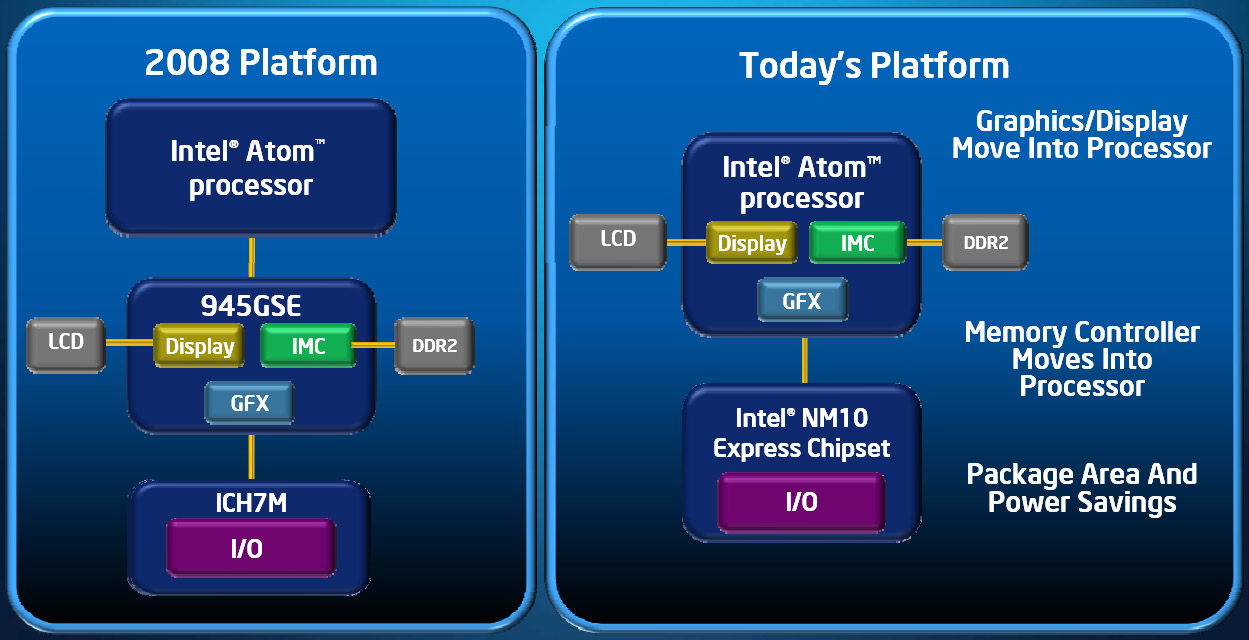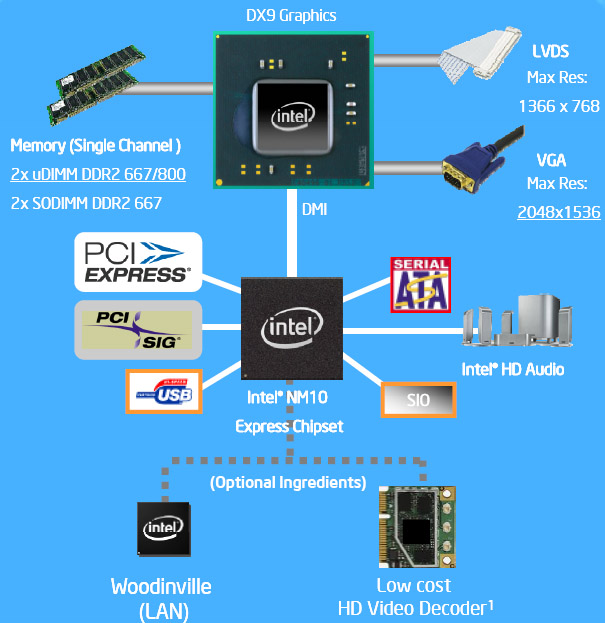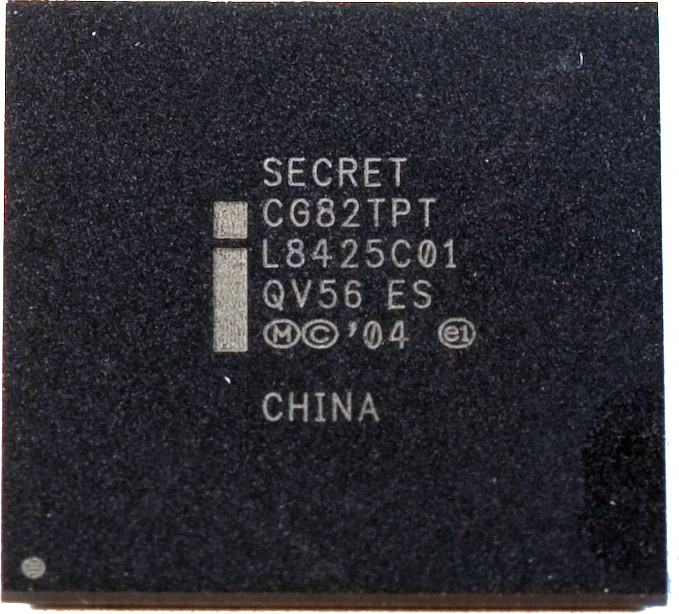Intel’s Atom D510 And NM10 Express: Down The Pine Trail With D510MO
A Big Win: No More 20W+ Platform
The first Atom-based desktop platforms consisted of an ironic combination of 4W CPU and 22.2W chipset, Intel’s 945GC. Mid-way through 2008, Intel launched the 945GSE at a more reasonable 6W (paired to a 3.3W ICH7M).
Match up an Atom 330 with 945GSE and you’ve got a very power-friendly 17.3W platform, albeit a somewhat inelegant three-chip platform based on older technology.
Nvidia isn’t as forthcoming with its TDP numbers, but Ion purportedly uses roughly 15W tops. So, an Atom 330/Ion arrangement would max out slightly higher at 23W. This could prove to be a detriment in mobile applications. But if HP’s Mini 311 has shown us anything, it’s that the graphics performance and video decoding capabilities of Ion help counterbalance higher power consumption.
With its Pine Trail platform, Intel shifts away from the three-chip configuration, integrates northbridge functionality into the processor die, and leaves the NM10 Express chipset to handle I/O. As a result, the CPU’s maximum TDP increases from 8W (dual-core Atom 330) to 13W (dual-core Atom N510), but you shed the 6.6W memory controller hub.
A Desktop-Oriented Atom Chipset
Intel won’t disclose the TDP, die size, or transistor count of NM10—formerly referred to as Tiger Point—but we know it’s manufactured at 45nm and populates a 17x17mm package. That’s a significant reduction from the 31x31mm ICH7, manufactured at 130nm. We’re going to assume, then, that NM10 uses less than the ICH7’s 3.3W TDP, putting platform power in the 16W or lower range—or right around what an Nvidia Ion chipset on its own uses.
With the functionality previously handled by northbridge technology sucked up into the CPU, what’s left for NM10 Express to address?
Get Tom's Hardware's best news and in-depth reviews, straight to your inbox.
Unlike US15W (Poulsbo), which was explicitly designed to incorporate northbridge, southbridge, and graphics duties for the Silverthorne-based Atom Z-series CPUs (in a 2.3W package, no less), NM10 features a decidedly more desktop-oriented pedigree. Among the chipset’s capabilities are two SATA 3 Gb/s ports, up to eight USB 2.0 ports, up to four PCI Express lanes (configurable as four x1 or one x4), and HD Audio.
Current page: A Big Win: No More 20W+ Platform
Prev Page Introduction Next Page A New Atom Lineup: Pineview Previewed-
It certainly is an improvement over the weak hearted Atom but I was expecting a bit more bang for the CPU's capabilities. Hopefully this will make Mini-ITX boards cheaper and more readily available for small servers and back up applications.Reply
-
scook9 My dad was looking at netbooks because he wanted something portable. What he ended up buying was the Dell Inspiron Mini 11z (not normally an inspiron fan). It has a Pentium Dual Core and the GM45 chipset (with HDMI output not VGA). This little 11" notebook gets over 6 hours of battery life and will run circles around either generation of atom processors and their chipsets/graphics. Yes the 11z did cost more than the other netbooks, but you got alot more for it, something to think about :)Reply -
matt87_50 wow, thats pretty terrible, one wonders how much better that new cpu integrated graphics is than the old chip set integrated? as basic as the ion system is, you can do anything with it, media center decoding HD, playing a couple of games, and as a file server, all with the lowest power consumption, this new one seems like its only good for the latter, and its only 3W less power.Reply
however, a file server / NAS alternative with the lowest possible power consumption is exactly what I'm after, so maybe its perfect for me, but I'd probably still go ION just because of the flexibility it offers in the future, should I get a new file server to replace it.
as for netbooks. If its a computer, I wanna be able to play games on it, and lets not forget about flash going 3D and hardware accelerated, I'd still go ION.
honestly, I wonder how they could make a GPU that crap in this day and age, the one in the iPhone and droid would be more powerful... -
little-ninja-man I just hop with this lower power usage we might see dual core atoms in netbooksReply -
liquidsnake718 I guess its not bad for beginners. I also have a netbook as my 3rd option.... I am rather enjoying the portability and functionality. As a HTCP or mini media center this sounds interesting for beginners that dont know how to build a PC... its almost plug and play..... this is a good option for them. I would prefer to get a mini-ITX board with at least a core 2 duo and build from there...... but then again, a PS2 is currently the king of this realm and you cannot compare as it has an HDMI, Great games, blu-ray, wifi, and everything one would need in this segment. Sorry the Cell is still far superior in this field!Reply -
tacoslave http://www.newegg.com/Product/Product.aspx?Item=N82E16813128342Reply
http://www.newegg.com/Product/Product.aspx?Item=N82E16819103706
quad core plus micro atx = amd win
-
djiezes Lack of HDMI, DVI or hardware accelerated decoding for MPEG4, x264 or h264 really does not make sense for a CPU/chipset that orients itself towards the desktop.Reply
Originally I thought this new chip might've made sense for htpc use. ION still beats it & ION2 is coming soon. An ordinary low powered desktop CPU for htpc use still makes more sense. AMDs Athlon X2 240E for example (45W) or maybe an Intel Pentium E3200 or alike. -
djiezes Lack of HDMI, DVI or hardware accelerated decoding for MPEG4, x264 or h264 really does not make sense for a CPU/chipset that orients itself towards the desktop.Reply
Originally I thought this new chip might've made sense for htpc use. ION still beats it & ION2 is coming soon. An ordinary low powered desktop CPU for htpc use still makes more sense. AMDs Athlon X2 240E for example (45W) or maybe an Intel Pentium E3200 or alike. -
yankeeDDL I have a question regarding the power efficiency. We see that in most tasks the Atoms are about 2X slower than the Pentium, and it seems to consume about 3~3,5X less under load.Reply
I wonder if a real/fair comparison of power consumption should be made differently.
For example: if I watch a DVD on an Atom I need, say, 100% CPU, while on a Pentium I will need only 50% of it.
So I will have the Atom burning power under full load vs 50% of the Pentium.
In other words: the Pentium is much more powerful, so it does not need to run full speed to do the same.
So, is there really an advantage in the Atom? Can you get the power/performance ratio of an Atom by simply underclocking a Pentium by few %?



